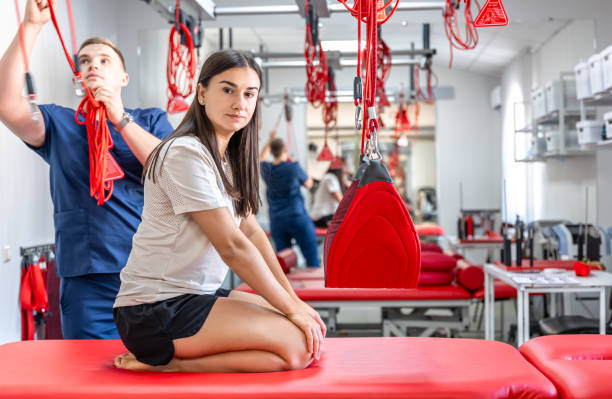As a student, you’re a professional sitter. From lectures to study sessions, from writing papers to binge-watching shows, you spend a huge amount of time sitting down. A sedentary lifestyle can cause back pain. When you add heavy backpacks and bad posture, it gets worse. These factors together create a perfect storm for discomfort. It’s a common problem, but it doesn’t have to be a permanent part of your life.
Back pain is more than just a distraction; it can affect your sleep, your ability to concentrate, and your overall well-being. It can make you feel old before your time and can even lead to more serious issues down the road if left unaddressed. But you don’t need a gym membership or expensive equipment to fix it. Physical therapy offers a simple, powerful solution.
This guide shows the top 5 physical therapy exercises just for students. They are easy to do anywhere, require no special gear, and can make a huge difference in how your back feels. View these as essential to your study routine. They help recharge your body and keep you healthy. This way, your mind can stay focused on what truly matters.
The Root of the Problem: Why Student Back Pain is So Common
Contents
Before we get to the solution, let’s understand the problem. Student back pain isn’t a random event; it’s a direct result of the habits that come with academic life.
The Desk-Bound Lifestyle
Think about how you sit. Is your back rounded? Are your shoulders hunched forward? When you sit for long periods in a chair that doesn’t support your spine, your muscles get tight and weak. Your core muscles—the ones that are supposed to hold you up—start to switch off. This puts all the stress of holding your body upright onto your back and neck, which aren’t built to handle it all alone. Think of your core as the foundation of a building; if the foundation is weak, the rest of the structure will be unstable.
Heavy Backpacks and Bad Posture
Your backpack is a major culprit. When you carry a heavy bag on one shoulder or a backpack that isn’t properly adjusted, it throws your body’s balance off. You lean forward and to the side to handle the weight. Over time, this constant shift can lead to muscle imbalances and spinal misalignment. It’s like carrying an uneven weight all day, every day, and your back is the part that has to suffer.
The Tech-Driven Habit
We live in a world of screens. Bending your neck to look down at your phone or laptop creates what’s known as “Tech Neck.” This simple action puts a massive amount of pressure on your neck and upper back. For every inch your head tilts forward, the pressure on your spine can increase by ten pounds. Imagine carrying a bowling ball on your neck for hours a day. That’s essentially what you’re doing, and it’s a key reason for the stiff neck and sharp upper back pain so many students feel.
The Muscle Imbalance Trap
Your body is a system of opposing muscles. For every muscle that works, there’s another that has to stretch. When you spend all day sitting, some muscles get very tight (like the hip flexors in the front of your hips and the pectoral muscles in your chest). At the same time, the muscles in your glutes and your upper back get weak from not being used. This imbalance pulls your body out of its natural alignment, creating a vicious cycle of pain and bad posture.
Your Back Pain Relief Toolkit: The Top 5 Physical Therapy Exercises
These exercises are simple, effective, and can be done without any special gear. Make them a part of your daily routine—a quick reset after a long study session.
1. Cat-Cow Stretch 🧘♂️
This gentle exercise is the perfect warm-up for your spine. It improves your spine’s flexibility and relieves tension in your lower back. It also helps to increase blood flow to your back muscles, which can help them feel less stiff.
- How to do it:
- Start on your hands and knees on the floor. Your hands should be directly under your shoulders, and your knees should be directly under your hips.
- Make sure your spine is in a straight, neutral position.
- For the “Cow” pose: Inhale slowly and deeply, arching your back and lifting your head and tailbone toward the ceiling. Let your belly sink down toward the floor. Imagine your spine curving into a gentle U-shape.
- For the “Cat” pose: Exhale and round your spine toward the ceiling, pulling your navel in toward your spine and tucking your chin to your chest. Imagine a Halloween cat with its back arched.
- Why it helps: The fluid, gentle motion of this exercise massages your spine and stretches the muscles in your back. It helps to release tension in a safe and controlled way, making your back feel less stiff. It’s a great way to warm up your spine, especially after waking up or before sitting down to study for a long period.
2. Bird-Dog Exercise 🐦
This exercise is fantastic for strengthening your core and the muscles in your lower back. A strong core is the foundation for a healthy back because it helps to support your spine and keep it stable, reducing your risk of pain.
- How to do it:
- Start on your hands and knees, just like in the Cat-Cow stretch. Keep your back flat and your neck in a neutral position, looking down at the floor.
- Slowly extend your right arm straight out in front of you while extending your left leg straight out behind you.
- Keep your hips level and your core tight so your body doesn’t wobble. Your body should form a straight line from your hand to your foot.
- Hold this position for 5-10 seconds, then slowly return to the starting position.
- Switch sides and repeat with your left arm and right leg.
- Why it helps: This exercise teaches your core and back muscles to work together to maintain balance and stability. It builds strength without putting any harmful pressure on your spine. It’s a perfect exercise to counteract the muscle weakness that comes from long hours of sitting. By training these stabilizing muscles, you reduce the strain on your lower back.
3. Glute Bridge 🌉
Sitting for long periods weakens your gluteal muscles (the muscles in your butt). These muscles are crucial for supporting your back and stabilizing your hips. When they get weak, other muscles have to work harder, which can lead to lower back pain.
- How to do it:
- Lie on your back with your knees bent and your feet flat on the floor, about hip-width apart.
- Keep your arms at your sides with your palms down.
- Engage your glutes and push your hips upward toward the ceiling until your body forms a straight line from your shoulders to your knees.
- Make sure you are pushing through your heels and not your toes. Avoid arching your lower back.
- Hold for a count of 5 seconds, then slowly lower your hips back down.
- Why it helps: This exercise directly targets your glutes and hamstrings, which are often inactive when you sit all day. By strengthening them, you provide better support for your lower back and help prevent pain. It’s a great exercise to add to a daily routine.
4. Knee-to-Chest Stretch 🤗
This easy stretch gives quick relief for tight lower back muscles. It also helps decompress the spine, easing the pressure from sitting.
- How to do it:
- Lie on your back with your knees bent and your feet on the floor.
- Bring one knee up to your chest and gently pull it with both hands until you feel a comfortable stretch in your lower back.
- Hold for 20-30 seconds. Breathe deeply as you hold the stretch.
- Repeat on the other side.
- For a deeper stretch, you can do this with both knees at the same time.
- Why it helps: This exercise gently stretches the muscles in your lower back and glutes. It’s an excellent way to relieve tension after a long day of studying and can help you feel more relaxed. It’s also a great way to relieve some of the pressure on your spinal discs.
5. Thoracic Extension 🤸
Spending hours hunched over a desk or phone can cause stiffness in your upper back (thoracic spine) and rounded shoulders. This exercise helps to improve your posture and flexibility in that area.
- How to do it:
- Sit on the edge of a chair or on the floor with your legs crossed.
- Clasp your hands behind your head, or cross your arms over your chest.
- Gently lean back over the back of the chair (or a rolled-up towel on the floor) and arch your upper back.
- Hold this position for 10-15 seconds.
- Repeat 5-10 times.
- Why it helps: This exercise directly counters the “slouching” posture that so many students adopt. It improves the flexibility in your upper back and chest, which makes it easier to stand and sit with good posture. By opening up your chest and upper back, you naturally feel taller and more aligned.
A Note on Breathing
It’s important to breathe correctly during these exercises. Inhale as you prepare for the movement and exhale as you perform the stretch or effort. Never hold your breath. Breathing deeply helps to oxygenate your muscles and allows you to get a deeper stretch and more benefit from the exercise.
Building a Habit: Making These Exercises Part of Your Life
Knowing the exercises is one thing; actually doing them is another. Here’s how you can build a consistent routine that lasts.
The Micro-Break Strategy
Don’t wait until you’re in pain. Set a timer on your phone for every 45-60 minutes of studying. When it goes off, stand up and do a few of these stretches. Even a 5-minute break is enough to make a difference.
Your Daily 15-Minute Routine
Try to do a full set of all 5 exercises at least once a day. You can do this first thing in the morning to prepare your body for the day, or at the end of the day to release tension before bed. Consistency is more important than duration.
The Power of a Study Buddy
Accountability works. Ask a friend to join you in a daily back-pain-relief routine. You can hold each other accountable and even remind each other to take a break during long study sessions.
The Power of a Recovery Playlist
Create a playlist of calm, instrumental music to listen to during your breaks. This can help you get into a relaxed, recovery mindset and mentally separate your break time from your study time. It’s a small change that can have a big impact on your ability to reset.
Frequently Asked Questions
Q1: Is this just for students?
A: No! These exercises are for anyone who spends long hours sitting, whether it’s a student, a writer, or an office worker. The principles of core strength and flexibility are universal.
Q2: How long until I see results?
A: You may feel some immediate relief from the stretches. For lasting results, you should aim for a few weeks of consistent practice. After a month, you should notice a significant reduction in pain and improved posture.
Q3: What if my pain gets worse?
A: Stop the exercise immediately and consult with a doctor or a physical therapist. While these exercises are generally safe, it’s important to listen to your body and not push through sharp pain.
Q4: Do I need special equipment?
A: All the exercises listed can be done with no equipment at all, just your body and a floor. A mat or a towel can make it more comfortable, but it’s not essential.
Q5: Can these exercises help with headaches?
A: Yes. Many headaches, especially for students, are caused by tension in the neck and upper back. By releasing this tension, these exercises can help reduce the frequency and intensity of tension headaches.
Q6: Should I see a physical therapist even if I’m not in severe pain?
A: Yes. A physical therapist can create a personalized plan to help you prevent pain and improve your posture before it becomes a bigger problem. Think of it as a proactive step for your long-term health.
Q7: How important is staying hydrated?
A: Very important. Staying hydrated keeps your spinal discs healthy. It helps them stay lubricated, so they absorb shock better. It’s a simple habit that can support your spine’s health.
Final Thoughts
Back pain is a common part of student life, but it doesn’t have to be. Take control of your health. Understand the causes and do these simple physical therapy exercises. Remember, a strong, pain-free body is a major key to a focused mind and academic success. So, take a break from your books, get on the floor, and start your journey to a healthier, more comfortable you.





